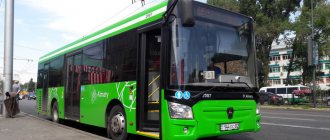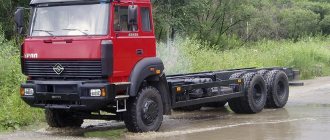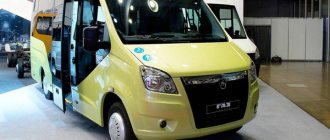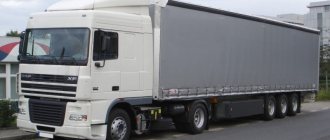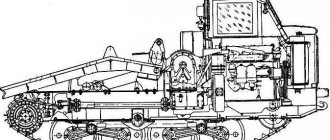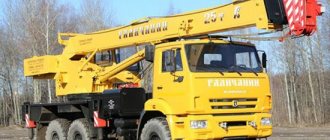New thing for a regular suburb
Daniil Minaev, photo by the author
When winter ends, 1,758 new buses will begin operating on regular bus routes in the Moscow region. These will be compact “Gazelle NEXT” (900 pcs.), 243 medium-capacity “Vector NEXT” PAZs, 75 low-floor LiAZ-5292.60 for urban transport and 540 LiAZ-5250 buses for suburban routes. Likinsky Bus) will produce a total of 615 large-class LiAZ-5292.60 and LiAZ-5250 Voyage buses specifically for the main Moscow region carrier, the Mostransavto holding. Upon completion of deliveries, the average age of rolling stock will be reduced by a third.
Three of the four models that will update the Mostransavto (MTA) fleet have already been repeatedly described on the pages of our magazine, but the 2022 LiAZ-5250 commuter bus, specified for the MTA, the production of which was transferred to Likino-Dulyovo from Golitsyno in 2014 , deserves a detailed description for a number of reasons.
Intercity bus LiAZ-5251 (53+1 seats)
LIAZ-5251 is designed to operate on intercity routes. The design of the LIAZ-5251 bus was developed taking into account modern trends in body production. The panoramic windshield and aquarium-type side glazing create an elegant image of an intercity airliner, providing maximum visibility of the road situation for drivers and passengers. The bus fully complies with all the requirements for the class of these buses. The larger volume of luggage compartments compared to its competitors, high-quality materials in interior design, new lighting, and a wide selection of comfortable passenger seats make the bus indispensable on routes between major cities.
| Basic characteristics | |
| Body type | Load-bearing, all-metal, carriage-type |
| Body life, years | 12 |
| Wheel formula | 4x2 |
| Length / Width / Height, mm | 12443 / 2550 / 3065 (3300 with air conditioning) |
| Base, mm | 6290 |
| Ceiling height in the cabin, mm | 2000 |
| Number / width of doors, mm | 2 / 740 |
| Min. turning radius, m | 11,8 |
| Curb/full weight, kg | 12600 / 18000 |
| Load on front/rear axle, kg | 6825 / 11175 |
| Total number of seats | (including boarding) 60(53+1) |
| Volume of luggage compartments, m3 | 7 |
| Fuel tank capacity, l | 310 |
| Main bridge | Scania (AMA 1300) |
| Steering gear | ZF with power steering |
| Brake system | Pneumatic with automatic brake clearance adjustment, completely independent circuits, ABS, ESP, engine brake |
| Suspension | Pneumatic, stabilizers on all axles, electronic suspension control system with body lifting/lowering function |
| Ventilation | Mixed: natural |
| Bathroom heating system - sunroofs; forced - front heater and Thermo King air conditioning system | Convector type, pre-starting liquid heater |
| Tires | 295/80 R22.5″ |
| Aggregate characteristics | |
| Engine (diesel) | Scania DC09 102, PDE injection system, turbocharging, EMS-si |
| Number and arrangement of cylinders engine management topic | 5-cylinder with 4 valves per cylinder, vertical in-line |
| Environmental safety standards | EURO-4 |
| Working volume, l | 9,29 |
| Engine power | kW (hp 184 (250) – 1800 min-1 |
| Max. torque, Nm | 1150 at 1200 min-1 |
| Location | Rear |
| Maximum speed, km/h | 120 |
| checkpoint | Scania GR875R (8 speed) manual, fully synchronized |
www.russian-bus.ru
According to specification
The length of the bus is 12,500 mm, width is 2,550 mm, height is 3,065 mm, and the wheelbase is 6,230 mm. Thanks to this axle configuration, a fairly compact “patch” with a radius of 11.8 m is required for a turn. The door formula is 1–2–0 (the rear door is in the base). According to the requirements of Mostransavto, the width of the passenger door openings was increased. The width of the front door opening is 740 mm, the rear door is 1350 mm. The height in the cabin is 2.0 m, and opposite the rear door opening there is space for a wheelchair, which also serves as a storage area.
Interior ventilation is mixed: natural through hatches in the roof; forced - with an exhaust fan. The heating system is of convector type, a pre-starting liquid heater is provided. The volume of the bus's luggage compartments has also increased, now it is 5 m3. As options, the Moscow region version of the LiAZ-5250 is equipped with the following “cream”: an on-board navigation and communication terminal, external and internal photo and video cameras, a rear view video camera, temperature and smoke sensors, an automatic fire detection and extinguishing system (AFS), a video recorder, an electronic -digital route indicators, auto-informer.
The safety systems on board include the following: anti-lock braking system (ABS), stability control (ESP), traction control (ASR), brake force distribution (EBD), emergency braking system (Brake Assist).
The service interval for the LiAZ-5250 is 45,000 km.
VOYAGE (LiAZ-525110 VOYAGE)
| Basic characteristics | LiAZ-525110 | LiAZ-525110 disabled |
| Body type | Load-bearing, all-metal, carriage-type | Load-bearing, all-metal, carriage-type |
| Body life, years | 12 | 12 |
| Wheel formula | 4x2 | 4x2 |
| Length/Width/Height, mm | 12500/2550/3065 (3300 with air conditioning) | 12500/2550/3065 (3300 with air conditioning) |
| Base, mm | 6230 | 6230 |
| Ceiling height in the cabin, mm | 2000 | 2000 |
| Formula/door width, mm | 1/740+1/740 | 1/740+2/ 1350 |
| Equipment for people with disabilities | No | Wheelchair lift |
| Min. turning radius, m | 11,8 | |
| Curb/full weight, kg | 12500…13500/18000 | 12500…13500/18000 |
| Maximum (technically permissible) load on the front/rear axle, kg | 6500/11500 | 6500/11500 |
| Total number of seats/seats | 60(53) | 60(47) |
| Number of places for people with disabilities, pcs. | No | 1 |
| Volume of luggage compartments, m3 | 6 | 5 |
| Fuel tank capacity, l | 310 | 310 |
| Axles front/rear | Scania AMA860/ADA1300 | Scania AMA860/ADA1300 |
| Chassis | Scania K250 IB4x2 | Scania K250 IB4x2 |
| Steering gear | ZF 8098, with power steering | ZF 8098, with power steering |
| Brake system | Electronic-pneumatic (EBS) with automatic adjustment of brake clearances, completely independent circuits, engine brake | Electronic-pneumatic (EBS) with automatic adjustment of brake clearances, completely independent circuits, engine brake |
| Retarder brake (retarder) | Scania | Scania |
| Suspension | Pneumatic, stabilizers on all axles, electronic suspension control system with body lifting/lowering function | Pneumatic, stabilizers on all axles, electronic suspension control system with body lifting/lowering function |
| Ventilation | Mixed: natural - sunroofs; forced - exhaust fan, front heater and climate control system | Mixed: natural - sunroofs; forced - exhaust fan, front heater and climate control system |
| Heating system | Convector type, pre-starting liquid heater | Convector type, pre-starting liquid heater |
| Glazing | Glued glass unit | Glued glass unit |
| Tires | 295/80 R 22.5″ | 295/80 R 22.5″ |
rusbus.ru
Another “Voyage” from Likino-Dulyovo
The production of LiAZ-5250 Voyage buses at the Likinsky Bus Plant is carried out in a separate area using the slipway assembly method, and not on the main conveyor where models -5256, -5292, -6212, -6213, -4292 are assembled. The Scania K250 IB4x2 self-propelled chassis arrives at the plant from Sweden.
From 2022, the in-line five-cylinder diesel engine of the Scania DC09 110 model produces 250 hp. became the fifth environmental class. Previously, a robotic gearbox was installed on the bus, which caused many complaints from operators and rarely lasted more than 250,000 km. And when operating in the most congested, heavily traffic-loaded first belt of the Moscow region (the territory from the Moscow Ring Road to the A-107 highway, colloquially referred to as the “first concrete road”), earlier failures were encountered, already at 100,000–150,000 km. In addition, the transmission experienced alternating shock loads when switching the worn “robot”; because of this, the driveshaft crosspieces had to be constantly repaired, the flanges were broken, and the power unit supports suffered.
This problem has been resolved. Now, in agreement with the carrier, the specification for the MTA includes a six-speed hydromechanical automatic transmission ZF 6AP-1200B. The front axle of the bus is Scania AMA860. It is designed for a load of 6.5 tons and is characterized by large steering angles. The axles of this model are specially designed for buses with a high center of gravity. Rear drive axle – Scania ADA1300. The gear ratio of the main pair is 3.08. The electronic-pneumatic brake system (EBS) with automatic adjustment of brake clearances has completely independent circuits and a motor retarder. Steering gear with hydraulic booster, model – ZF 8098.
Technical characteristics of the LiAZ-525000 bus
| Wheel formula | 4x2 |
| Body type | Load-bearing, all-metal, carriage-type |
| Body life, years | 12 |
| Total weight, kg | 18 000 |
| Axle load distribution, kg | 6500/11 500 |
| Minimum turning radius, m | 11,8 |
| Fuel tank capacity, l | 310 |
| Maximum speed, km/h | 100 |
| Length, mm | 12 500 |
| Width, mm | 2550 |
| Passenger capacity, persons | 60 (47 seats, 12 standing, 1 wheelchair) |
| Wheel formula | 4x2 |
Engine:
| DC09 110, Euro 5 Turbodiesel, 5 cylinders in line 9.29 184 (250) at 1800 min-1 1150 at 1300 min-1 |
Transmission:
| ZF 6AP-1200B 6/1 |
| Suspension | Pneumatic, anti-roll bars on all axles, electronic suspension control system with body lifting/lowering function |
| Luggage compartment capacity, m3 | 5,0 |
| Tire size | 295/80 R22.5 |
Review of LiAZ-5250. All familiar faces
[]
In the segment of commuter buses, the LiAZ-5250 model, also known as “Voyage”, which became the successor to the GolAZ of the same name, is fighting for the client-carrier. As before, one of the main operators of this machine is.
text: Oleg Prokhorov / photo: author / 05.14.2018
Every domestic carrier and passenger has encountered the LiAZ manufacturer at least once in their life. In the last 20 years, the trend is that the distribution area of Likino cars has shifted to the central region of our country, where such buses have been running on most urban and suburban routes for decades. In the eastern part of Russia, NefAZ dominates in the medium and large capacity segment. The first urban NefAZ was released in 2000, since then the range of produced models has been expanded many times: in addition to urban ones, suburban, intercity and, of course, tourist models have appeared. In the 2000s, in Neftekamsk they launched the production of intercity NefAZ-5299ST and NefAZ-5299KT - analogues of the LiAZ-5250. In the southern regions of our Motherland, passengers are transported by buses, which were the first Russian manufacturer to take part in the prestigious European bus exhibition Busworld in Kortrijk, Belgium.
Scania instrument cluster with on-board computer screen.
This territorial division is not accidental: regions support their own brands. In the Moscow region, the consumer of the Likinsky Automobile Plant is traditionally Mostransavto, which also includes the LiAZ-5250 on its balance sheet. The Voyage, which moved from Golitsyno in 2013, has remained virtually unchanged; its predecessor can only be distinguished by emblems and minor details, mostly of an internal structural nature (door drives, the quality of the adhesive materials used, an updated transmission, and so on). The bus is made in the same corporate style, with details characteristic of the brand. According to modern standards, the bus is equipped with Hella miniature lensed front optics. The designers followed almost all the canons of the appearance of the suburban model: although the silhouette was not very “licked” for the sake of better aerodynamics, but with a large, slightly curved windshield, providing not only the driver, but also the passengers with a good view during the trip. In recent years, the exterior of LiAZ vehicles has acquired better quality side glazing - double-glazed windows with windows, fan-type windshield wipers, as well as a driver's window integrated into the glass (electrically heated). One of the innovations noticeable to connoisseurs of Likino buses is the introduction of a lighter plastic roof. Its steel counterpart weighed many times more. All these innovations also affected the 5250 model, during the assembly of which adhesive technologies are increasingly used to provide waterproofing and the necessary mobility of the joint. The wheel arches now have an increased protective layer, and there is a multi-layer anti-gravel treatment on the bottom and skirt.
Pneumatic cylinders are covered with protective covers.
The towing eye screws into the hole behind the hood.
The interior is quite spacious; the passenger seats are installed on a low podium as standard for this arrangement. Each chair, according to the rules of intercity transportation, is equipped with seat belts, backrests with tilt adjustment, retractable armrests and folding tables. To monitor the road and passengers, a video recorder of the progress of traffic, video cameras in the passenger compartment and driver's cabin, as well as rear view cameras that display an image on the monitor and are recorded in the drive memory have been introduced. By the way, these recordings have repeatedly saved drivers from false accusations of being at fault for road accidents and more. Other control systems include GLONASS and digital tachograph. In the recent past, Voyage cars were equipped with extremely uncomfortable driver’s seats, which made the working day seem like “hard labor.” In the latest versions, at the request of a key customer, comfortable seats with numerous adjustments were installed, and this problem went away. The instrument panel is clearly visible, as is the instrument cluster; An informative display and ergonomic controls, including buttons for shifting automatic transmission gears, create additional comfort for work.
The spacious interior will not make passengers regret the last trip.
The Likinsky plant has been cooperating with the Swedish manufacturer Scania for many years, purchasing chassis for its buses from them. Model 5250 is no exception; it is built on such an imported chassis. In the rear overhang of the Voyage is an in-line 5-cylinder Scania DC09 109 engine, corresponding to the Euro-5 environmental class with a displacement of 9.29 liters. Its power is 250 hp. s., and the maximum torque is 1150 Nm at 1000–1300 min-1. To comply with Euro 5 standards, urea solution (AdBlue) injectors are installed in the engine exhaust system. The liquid is supplied from a tank located in the compartment on the starboard side. The AdBlue level is displayed on the on-board computer display, and when the volume drops to 20%, a refueling indicator will appear. It is important to know that the manufacturer prohibits filling the tank to the top, since if the reagent crystallizes, the tank’s ventilation system may become clogged. Also, under special conditions, there is a ban on disconnecting the ground during self-cleaning of the bus SCR system. This action will be indicated by the battery icon and the hourglass icon on the dashboard.
A ramp is provided for passengers with disabilities.
The engine oil level can be monitored during daily inspection - by the level on the dipstick and while driving - by the indicator light on the instrument panel. If the lamp is on, you need to add oil or drain it if there is too much oil. A high oil level leads to excessive oil consumption due to release into the crankcase ventilation system. The same principle is used to control the coolant level in the engine: a lamp on the instrument panel will indicate the presence of a problem. Visual control of antifreeze is possible through a transparent tube on the expansion tank. If a fire emergency occurs, the standard fire alarm device with a detector in the engine compartment will notify the driver of the danger and begin extinguishing the fire.
The luggage compartment, depending on the configuration, can reach 6 m3.
In Voyage buses, torque is transmitted from the engine to the rear axle by a 6-speed automatic transmission manufactured by ZF Ecolife series model 6AP-1200B. It makes the driver's work easier and reduces the load on the transmission. Also, due to numerous requests from the operator, the GMT replaced the robotic gearbox. The reason here is the short service life of the “robot” and the clutch in mixed operating modes (city, suburb). In a hydraulic transmission, a torque converter with a reactor installed on the freewheel is a non-wearing device when starting off. When the speed increases, the torque converter is blocked: torque is transmitted from the flywheel to the box directly, with the same frequency. Thus, power losses are eliminated.
The rear overhang houses an in-line 5‑cylinder turbodiesel from Scania.
The rear axle of the Scania R660 with a hypoid main pair (gear ratio 3.07) rests on a dependent air suspension with four cylinders. For stability in corners, the suspension is equipped with an anti-roll bar and two body position adjusters. The front suspension is also dependent, pneumatic, with a stabilizer and body level sensors. The steering knuckles of the steered wheels rest on a pivot joint, which requires lubrication through grease fittings every 60,000 km. Checking radial play is necessary every 120,000 km. It is noteworthy that the maximum clearance in the king pins is no more than 0.4 mm, which corresponds to a 1.5 mm movement of the threaded part of the steering knuckle.
In the stern on the starboard side there is a 75 liter urea tank.
The pneumatic brake system is equipped with an electronic anti-lock braking system EBS and an ASR traction control system. In addition, the automatic transmission's primary retarder is integrated into the vehicle's braking system and provides high braking power even at low speeds. This ensures gentle operation of the service brake system, in our case with disc mechanisms.
The fuel pre-filter does not provide heating.
Technical characteristics of LiAZ-5250 | |
| Dimensions (length/width) | 12 500/2550 mm |
| Wheel formula | 4x2 |
| Body type | load-bearing, carriage layout |
| Full mass | 18,000 kg |
| Minimum turning radius | 11.8 m |
| Fuel tank volume | 310 l |
| Passenger capacity | 60 people (47 seats) |
| Engine | DC09 109, Euro-5, diesel, 5 cylinders in line, 9.29 l, 250 l. With. at 1800 min-1, 1150 Nm at 1000–1300 min-1 |
| Transmission | ZF 6AP-1200B, number of steps forward/backward - 6/1 |
| Suspension | pneumatic, anti-roll bars on all axles |
| Luggage compartment capacity | 5.0 m3 |
| Tire size | 295/80R22.5 |
| Factory warranty | 3 years unlimited mileage |
| Service mileage | from 20,000 to 90,000 km |
| Competitors | MAZ-231062, MAN Lion's Regio |
At the customer's request, the power of the autonomous heater was increased to 32 kW.
- Modern appearance, comfortable passenger seats, the ability to equip a hydraulic transmission with a built-in retarder.
- The noise from the power plant reverberates throughout the cabin. Coarse fuel filter without heating.
Anton Malafeev, head of the Mostransavto column, AK 1788
In 2013, we received the first GolAZ-5251. Before we put anyone behind the wheel, we sent mentor drivers to Scania, who in turn passed on skills to the core team. And this is at least 16 hours, that is, two working days. Skill in working, including with a robotic gearbox, was required, since the gearbox provided two modes - manual and automatic. With the advent of the hydromechanical gearbox, driving the bus became easier, and the number of transmission failures also decreased significantly. But at the same time, fuel consumption increased by 10% (to 43 l/100 km), and this was predictable. Today, the service interval for Voyages is 20,000 km, or in our case once a month. Maintenance usually takes no more than 4 hours, after which the car returns to the park and lines up with another driver. We do not perform additional control operations before release onto the line. Until now, all necessary operations have been carried out conscientiously by the Scania service center. If for any reason intervention in the form of repairs is required, our mechanics will be able to perform it. They, like the drivers, have been trained to repair the main components and assemblies of buses of different brands.
These vehicles, like all others in the fleet, are equipped with monitoring and video surveillance systems, and we use this information every day. It helps us in calculating passenger flow, in identifying linear violations by drivers and conductors, and in monitoring compliance with traffic rules. Just yesterday we were dealing with a controversial case of an accident, where they tried to accuse our driver of violating the rules. Having studied the recordings of CCTV cameras, we found out that the second participant abruptly changed lanes after overtaking in the oncoming lane. The bus driver could not apply emergency braking because there were passengers on board. As a result, the culprit was found to be the one who had made such a thoughtless reconstruction, and also with the deprivation of his rights. The video monitoring system helps drivers both when maneuvering and when boarding and disembarking passengers at stops. Now the monitoring system is being updated, after which the information from the cameras can also be seen by the control center.
The ZF-Ecolife hydromechanical gearbox is more suitable for urban driving.
The spare wheel is traditionally suspended in the front overhang of the bus.
The front suspension is dependent pneumatic, with powerful rods.
The engine compartment is protected by an automatic fire extinguishing system.
The brakes are disc and are assisted by a retarder.
Sergey Filimonov, director of the Mostransavto branch, AK 1788
Our company has 210 linear buses and a garage department, of which 16 are “Voyage” models LiAZ-5250 and GolAZ-525110. In addition to suburban ones, there are, of course, urban ones, including modern low-floor LiAZ-4292 and LiAZ-5292 - both with MAN engines and YaMZ-534, 536. Veterans of the LiAZ-6212, quite reliable cars, also remain in service. but the years take their toll: they have been in operation for more than 10 years, and today there are nine of them left. There are also Korean Hyundai Universe buses, purchased in 2011, which have already covered a million kilometers and are also quite reliable.
There was a powerful breakthrough for the LiAZ-5250 model when a hydromechanical gearbox was installed on this bus instead of a “robot”. This was an urgent need for operation on several of our routes. We started receiving such machines last year in several batches, the last ten came to us in 2022. During the warranty period, we service the equipment at a Scania dealer, and now we are working on a life cycle contract, when the manufacturer maintains and repairs the machines for the entire period of operation. The contract implies a monthly subscription fee, which includes a full range of work for 7 years of bus ownership (3 years of warranty plus 4 years of post-warranty maintenance and repairs). For breakdowns caused by the carrier, a deductible is provided, as in an insurance policy. The next positive aspect of this agreement is a replacement fleet if repairs are not completed within more than 3 days. So far everything is at the stage of a pilot project, but its promise is already visible, even taking into account the fact that the equipment will have to be driven to a third-party station, wasting time and fuel. After all, our main profile is the transportation of passengers, and this is where we can fully concentrate. There is no need to worry about repairmen being left without work yet, since these plans apply only to new equipment and only on Scania chassis. We cannot do without the GAZ Group in this matter, since this is their product, and we have all contractual relations with them.
We are currently working with a dealer of the Swedish manufacturer under warranty conditions, which includes 3 years without mileage limitation. The contract provides for a period of 13 days to correct factory defects, of which 3 are for maintenance and troubleshooting and another 10 for possible repairs. The Swedish chassis causes almost no problems during operation, but only if the manufacturer's recommendations are followed. Unfortunately, domestic units cannot boast of such quality, no matter how you service them. There were some shortcomings regarding the body specifically for the GolAZ-5251, which we discussed with the manufacturer. During the cold season, drivers were terribly cold due to the fact that it was blowing from everywhere, and their legs especially suffered. The blowers were replaced with anti-vandal ones, as they were constantly being broken. The door drives were changed to Italian ones; the previous ones were of frankly poor quality. Steel tanks were installed under the urea; they constantly flowed. Now plastic is used instead of metal. Increased air conditioner power. The previous sample was not able to pump the entire interior. The power of the cabin heater has increased from 28 to 32 kW. To ventilate the interior, at our request, window vents were integrated. There were also a lot of minor glitches when the loops of the bows broke, the bumpers attached to the glue fell, and so on. We changed the lighting equipment to LED, which, of course, is more expensive if it breaks down. But the problems with poor contact, when the heated incandescent light bulb socket burned the lamp, went away.
5koleso.ru
Voyage on Voyage: assessing the health of suburban LiAZs on Scania chassis
Voyage buses have a difficult fate. Under the now defunct GolAZ brand, they, without exaggeration, became the transport face of the Sochi Olympics in 2014 (I managed to attend the opening of their production in 2013). And immediately after the Games they were handed over to the Moscow region carrier Mostransavto - and those buses still travel around the Moscow region. And this year they were joined by similar vehicles - similar in appearance, on the same Scania units, but under the LiAZ brand. At the Swedish brand's service station in Golitsyno, I watched them undergo maintenance, and also found out something about technical problems.
Several buses are being serviced in the workshop at once
Only LiAZs are serviced here - the Moscow Region carrier received 540 of these buses along with a service contract, which includes periodic maintenance and warranty repairs. But the parks maintain and repair 709 older Olympic GolAZ vehicles on their own, albeit using proprietary technologies.
The compartment near the driver houses the batteries and fuse boxes.
By the way, the main complaints of carriers are also addressed to old GolAZs. The 250-horsepower engine works on them without problems, but Scania’s “robot” Opticruise is great for long marches, but it doesn’t like routes with frequent stops and traffic jams - and quickly breaks down.
The Scania engine works great on buses, but the new LiAZs have a classic ZF automatic transmission, not a robot.
Mostransavto began looking for solutions to this problem and even installed a conventional Allison automatic transmission on one such bus. The bus went along the route with her without any problems. Therefore, in the current conditions of limited resources, converting old buses to automatic buses can be profitable. Moreover, all new LiAZs are also equipped with classic automatic transmissions - but not Allison, but ZF.
Service covers on the steering wheel and seat
The carriers did not identify any other serious technical problems. There are, however, complaints about the bodies: on the same old GolAZs, sometimes the side windows even begin to leak. Likino cars do not have such problems.
On buses near Moscow, as well as in the capital, you can pay for travel by tapping your card to the validator
And the real disaster for carriers is vandal passengers who vandalize the interior for fun, not even embarrassed by video surveillance systems. It gets to the point where you have to put poor gray covers made of durable fabric on the beautiful blue seats: it’s better to let them suffer than the upholstery.
The LiAZ emblem is flat and hard to read
By the way, according to the contract, Scania dealers are responsible not only for the chassis, but also for the entire bus. Therefore, if repairs are required to elements of the body or interior, then it is also performed at stations of the Swedish brand.
Buses are serviced in the same room as trucks
As for maintenance, its Mostransavto Voyages can take place only in two places - in Golitsyno, as well as at the recently opened service station in Noginsk. And every 45 thousand kilometers, buses from numerous parks near Moscow have to be taken off the line and idly driven into service - inconvenient, but these are, apparently, the terms of the contract.
Maintenance lasts about four to five hours and includes standard procedures such as checking and adjusting wheel alignment and replacing brake pads. And according to Mostransavto, despite all the logistical features of the process, service from dealers using exclusively original parts bears fruit. If last year 94% of all flights were operated since the beginning of autumn, then this year this figure has increased to 99%.
LiAZ-5293 - Wikipedia
Material from Wikipedia - the free encyclopedia
The current version of the page has not yet been verified by experienced participants and may differ significantly from the version verified on April 22, 2013; checks require 53 edits. The current version of the page has not yet been verified by experienced participants and may differ significantly from the version verified on April 22, 2013; checks require 53 edits. Skip to navigation Skip to search
| LiAZ-5293 | |
| Manufacturing plant | LiAZ |
| Project, g | 2005 |
| Produced, years | |
| Instances: | 1907 (as of December 2017)[1] |
| Gross weight, t | 17, 1 — 17, 6 |
| Curb weight, t | 10, 1 — 10, 6 |
| Max. speed, km/h | 90 |
| Bus class |
|
| ECO standard | Euro-3 - Euro-4 - Euro-5 |
| Capacity | |
| Seating | 23 (24) |
| Nominal capacity (5 people/m²) | 104 |
| Full capacity (8 people/m²) | 116 |
| Dimensions | |
| Length, mm | |
en.wikipedia.org
low-floor city bus with many modifications
The LiAZ-5292 city bus (large class, low-floor configuration) was presented at the 2003 Moscow Motor Show. The car at that time was equipped with a transverse Caterpillar power plant combined with a Voith automatic transmission. The chassis consisted of two portal bridges. The LiAZ-5292 bus was put into mass production and began to arrive in small batches to the fleets of Moscow, as well as to Voronezh, Ivanovo, Kursk and other large cities.
Modernization
The model did not justify itself; mass write-offs began in Moscow motor vehicles already in 2014. A deep modernization was required, replacing the engine with a more powerful one, improving the steering mechanism and door servos. In addition, on the base LiAZ-5292, the air conditioning system did not work well in hot weather, as a result of which the entire rear part of the cabin overheated, creating uncomfortable conditions for passengers.
The modified bus was assigned the index 5292-20. The main difference from the base model was the new MAN D0836 LON engine, which complies with Euro 4 environmental standards. The dashboard from the LiAZ-6213 model was installed on the car, as it has proven itself. Point optics were used. Air conditioning systems were installed in two types - “Konvekta” and “Speros”. In the summer of 2011, mass deliveries of the new model began to motor vehicles in Moscow and to individual Russian regions.
Glass doors
The next modification, LiAZ-5292-22, was put into production in December 2013. The car was equipped with solid glass doors with a rubber-metal frame. All manufactured buses of this modification are at the disposal of the State Unitary Enterprise MO Mostransavto.
At the same time, a small batch of commuter-type cars was produced. These buses did not have a back door, the number of seats in them was increased to 32. The first batch of 50 cars was sent to Sochi.
In total, from the beginning of production to the present time, more than ten different modifications have been created at the Likinsky Automobile Plant, which successfully operate on urban and suburban routes in many Russian cities. In general, the operation of the LiAZ-5292 is already paying off, and the car is even being exported. The Russian Ministry of Transport receives positive feedback from foreign partners.
Battery power
A modification of LiAZ-5292-6274 (an experimental electric bus) is being assembled at a separate production facility. The machine is equipped with lithium batteries. The power reserve when fully charged is about two hundred kilometers. Recharging is carried out at special stations equipped with terminals for six gas stations.
The Likinsky plant has also launched production of a bus with a LiAZ-5292-71 gas engine. These machines have been operating since 2010. After the incident with the explosion of a gas tank, which occurred on May 9, 2013, all buses with a gas engine were removed from the routes. However, no system defects were found, and gradually all the cars returned to the streets of Moscow. Twenty-nine buses operate in the periphery, mainly in Khimki. Thirty gas cars run in Chelyabinsk, and the same number in St. Petersburg. At the end of 2015, a large batch of buses was sent to Crimea, some of them operate on city routes in Simferopol, some are operated on the Simferopol-Alushta highway.
LiAZ-5292: technical characteristics
Weight and dimensional parameters:
- bus length - 11,990 mm;
- height - 2,880 mm;
- width - 2-500 mm;
- wheelbase - 5,960 mm;
- wheel formula - 4 x 2;
- width of doorways - 2 x 1325 and 1 x 1225 mm;
- number of doors - 3;
- interior ceiling height - 2280 mm;
- total weight - 18,390 kg;
- turning radius is 11.5 meters.
Power point
The bus is equipped with an engine from the German company MAN (model MAN D0836LOH with turbocharging).
Motor characteristics:
- number of cylinders - 6;
- vertical location;
- environmental standard - Euro 4;
- total working volume of cylinders - 6,870 cubic cm;
- maximum power - 176 hp at a rotation speed of 2400 rpm;
- torque - 925 Nm at 1800 rpm;
- engine location is rear.
Chassis
Basically, bus suspensions are assembled from units supplied by German manufacturers. The LiAZ-5292 bus, the characteristics and parameters of which indicate its reliability and durability, is gradually switching to domestically produced units. The quality of Russian parts at this stage is no worse than imported ones, and the quality of steel is even superior to their foreign counterparts.
A distinctive feature of the model is the built-in system of tilting the body towards the landing platform at stops. This is done to facilitate entry into the salon for wheelchair users. A special ramp extends from the underground space, along which a passenger with disabilities enters. The bus meets all operating requirements in big cities. The total passenger capacity of the cabin is 112 people. Seats - 20.
fb.ru
Review of the LiAZ-5250 Voyage bus based on the SCANIA chassis
In the segment of commuter buses, the LiAZ-5250 model, also known as “Voyage”, which became the successor to the GolAZ of the same name, is fighting for the client-carrier. As before, one of the main operators of this machine is.
Every domestic carrier and passenger has encountered the LiAZ manufacturer at least once in their life. In the last 20 years, the trend is that the distribution area of Likino cars has shifted to the central region of our country, where such buses have been running on most urban and suburban routes for decades.
Scania instrument cluster with on-board computer screen.
In the Moscow region, the consumer of the Likinsky Automobile Plant is traditionally Mostransavto, which also includes the LiAZ-5250 on its balance sheet. “Voyage” has remained virtually unchanged; GoLAZ’s predecessor can only be distinguished by emblems and minor details, mostly of an internal structural nature (door drives, quality of adhesive materials used, updated transmission, and so on). The bus is made in the same corporate style, with details characteristic of the brand. According to modern standards, the bus is equipped with Hella miniature lensed front optics. The designers followed almost all the canons of the appearance of the suburban model: although the silhouette was not very “licked” for the sake of better aerodynamics, but with a large, slightly curved windshield, providing not only the driver, but also the passengers with a good view during the trip. In recent years, the exterior of LiAZ vehicles has acquired better quality side glazing - double-glazed windows with windows, fan-type windshield wipers, as well as a driver's window integrated into the glass (electrically heated). One of the innovations noticeable to connoisseurs of Likino buses is the introduction of a lighter plastic roof. Its steel counterpart weighed many times more. All these innovations also affected the 5250 model, during the assembly of which adhesive technologies are increasingly used to provide waterproofing and the necessary mobility of the joint. The wheel arches now have an increased protective layer, and there is a multi-layer anti-gravel treatment on the bottom and skirt.
Pneumatic cylinders are covered with protective covers.
The towing eye screws into the hole behind the hood.
The interior is quite spacious; the passenger seats are installed on a low podium as standard for this arrangement. Each chair, according to the rules of intercity transportation, is equipped with seat belts, backrests with tilt adjustment, retractable armrests and folding tables. To monitor the road and passengers, a video recorder of the progress of traffic, video cameras in the passenger compartment and driver's cabin, as well as rear view cameras that display an image on the monitor and are recorded in the drive memory have been introduced. By the way, these recordings have repeatedly saved drivers from false accusations of being at fault for road accidents and more. Other control systems include GLONASS and digital tachograph. In the recent past, Voyage cars were equipped with extremely uncomfortable driver’s seats, which made the working day seem like “hard labor.” In the latest versions, at the request of a key customer, comfortable seats with numerous adjustments were installed, and this problem went away. The instrument panel is clearly visible, as is the instrument cluster; An informative display and ergonomic controls, including buttons for shifting automatic transmission gears, create additional comfort for work.
The spacious interior will not make passengers regret the last trip.
The Likinsky plant has been cooperating with Scania for many years, purchasing chassis for its buses from it. Model 5250 is no exception; it is built on such an imported chassis. In the rear overhang of the Voyage is an in-line 5-cylinder Scania DC09 109 engine, corresponding to the Euro-5 environmental class with a displacement of 9.29 liters. Its power is 250 hp. s., and the maximum torque is 1150 Nm at 1000–1300 min-1. To comply with Euro 5 standards, urea solution (AdBlue) injectors are installed in the engine exhaust system. The liquid is supplied from a tank located in the compartment on the starboard side. The AdBlue level is displayed on the on-board computer display, and when the volume drops to 20%, a refueling indicator will appear. It is important to know that the manufacturer prohibits filling the tank to the top, since if the reagent crystallizes, the tank’s ventilation system may become clogged. Also, under special conditions, there is a ban on disconnecting the ground during self-cleaning of the bus SCR system. This action will be indicated by the battery icon and the hourglass icon on the dashboard.
A ramp is provided for passengers with disabilities.
The engine oil level can be monitored during daily inspection - by the level on the dipstick and while driving - by the indicator light on the instrument panel. If the lamp is on, you need to add oil or drain it if there is too much oil. A high oil level leads to excessive oil consumption due to release into the crankcase ventilation system. The same principle is used to control the coolant level in the engine: a lamp on the instrument panel will indicate the presence of a problem. Visual control of antifreeze is possible through a transparent tube on the expansion tank. If a fire emergency occurs, the standard fire alarm device with a detector in the engine compartment will notify the driver of the danger and begin extinguishing the fire.
The luggage compartment, depending on the configuration, can reach 6 m3.
In Voyage buses, torque is transmitted from the engine to the rear axle by a 6-speed automatic transmission manufactured by ZF Ecolife series model 6AP-1200B. It makes the driver's work easier and reduces the load on the transmission. Also, due to numerous requests from the operator, the GMT replaced the robotic gearbox. The reason here is the short service life of the “robot” and the clutch in mixed operating modes (city, suburb). In a hydraulic transmission, a torque converter with a reactor installed on the freewheel is a non-wearing device when starting off. When the speed increases, the torque converter is blocked: torque is transmitted from the flywheel to the box directly, with the same frequency. Thus, power losses are eliminated.
The rear overhang houses an in-line 5‑cylinder turbodiesel from Scania.
The rear axle of the Scania R660 with a hypoid main pair (gear ratio 3.07) rests on a dependent air suspension with four cylinders. For stability in corners, the suspension is equipped with an anti-roll bar and two body position adjusters. The front suspension is also dependent, pneumatic, with a stabilizer and body level sensors. The steering knuckles of the steered wheels rest on a pivot joint, which requires lubrication through grease fittings every 60,000 km. Checking radial play is necessary every 120,000 km. It is noteworthy that the maximum clearance in the king pins is no more than 0.4 mm, which corresponds to a 1.5 mm movement of the threaded part of the steering knuckle.
In the stern on the starboard side there is a 75 liter urea tank.
The pneumatic brake system is equipped with an electronic anti-lock braking system EBS and an ASR traction control system. In addition, the automatic transmission's primary retarder is integrated into the vehicle's braking system and provides high braking power even at low speeds. This ensures gentle operation of the service brake system, in our case with disc mechanisms.
At the customer's request, the power of the autonomous heater was increased to 32 kW.
Modern appearance, comfortable passenger seats, the ability to equip a hydraulic transmission with a built-in retarder.
The noise from the power plant reverberates throughout the cabin. Coarse fuel filter without heating.
Anton Malafeev, head of the Mostransavto column, AK 1788
In 2013, we received the first GolAZ-5251. Before we put anyone behind the wheel, we sent mentor drivers to Scania, who in turn passed on skills to the core team. And this is at least 16 hours, that is, two working days. Skill in working, including with a robotic gearbox, was required, since the gearbox provided two modes - manual and automatic. With the advent of the hydromechanical gearbox, driving the bus became easier, and the number of transmission failures also decreased significantly. But at the same time, fuel consumption increased by 10% (to 43 l/100 km), and this was predictable. Today, the service interval for Voyages is 20,000 km, or in our case once a month. Maintenance usually takes no more than 4 hours, after which the car returns to the park and lines up with another driver. We do not perform additional control operations before release onto the line. Until now, all necessary operations have been carried out conscientiously by the Scania service center. If for any reason intervention in the form of repairs is required, our mechanics will be able to perform it. They, like the drivers, have been trained to repair the main components and assemblies of buses of different brands.
The ZF-Ecolife hydromechanical gearbox is more suitable for urban driving.
The spare wheel is traditionally suspended in the front overhang of the bus.
The front suspension is dependent pneumatic, with powerful rods.
The engine compartment is protected by an automatic fire extinguishing system.
The brakes are disc and are assisted by a retarder.
Sergey Filimonov, director of the Mostransavto branch, AK 1788
Our company has 210 linear buses and a garage department, of which 16 are “Voyage” models LiAZ-5250 and GolAZ-525110. In addition to suburban ones, there are, of course, urban ones, including modern low-floor LiAZ-4292 and LiAZ-5292 - both with MAN engines and YaMZ-534, 536. Veterans of the LiAZ-6212, quite reliable cars, also remain in service. but the years take their toll: they have been in operation for more than 10 years, and today there are nine of them left. There are also Korean Hyundai Universe buses, purchased in 2011, which have already covered a million kilometers and are also quite reliable.
There was a powerful breakthrough for the LiAZ-5250 model when a hydromechanical gearbox was installed on this bus instead of a “robot”. This was an urgent need for operation on several of our routes. We started receiving such machines last year in several batches, the last ten came to us in 2022. During the warranty period, we service the equipment at a Scania dealer, and now we are working on a life cycle contract, when the manufacturer maintains and repairs the machines for the entire period of operation. The contract implies a monthly subscription fee, which includes a full range of work for 7 years of bus ownership (3 years of warranty plus 4 years of post-warranty maintenance and repairs). For breakdowns caused by the carrier, a deductible is provided, as in an insurance policy. The next positive aspect of this agreement is a replacement fleet if repairs are not completed within more than 3 days. So far everything is at the stage of a pilot project, but its promise is already visible, even taking into account the fact that the equipment will have to be driven to a third-party station, wasting time and fuel. After all, our main profile is the transportation of passengers, and this is where we can fully concentrate. There is no need to worry about repairmen being left without work yet, since these plans apply only to new equipment and only on Scania chassis. We cannot do without the GAZ Group in this matter, since this is their product, and we have all contractual relations with them.
We are currently working with the manufacturer's Scania dealer under warranty conditions, which include 3 years without mileage limitation. The contract provides for a period of 13 days to correct factory defects, of which 3 are for maintenance and troubleshooting and another 10 for possible repairs. The Scania chassis causes almost no problems during operation, but only if the manufacturer's recommendations are followed. Unfortunately, domestic units cannot boast of such quality, no matter how you service them.
LiAZ-6212 Wikipedia
| LiAZ-6212 | |
| LiAZ-6212.01 of the 15th bus depot in Moscow | |
| Manufacturing plant | LiAZ |
| Project, g | 1993 |
| Produced, years | |
| Instances: | 1332 |
| Gross weight, t | 27, 5 |
| Curb weight, t | 15, 2 |
| Max. speed, km/h | 90 |
| Bus class |
|
| ECO standard | Euro-3 - Euro-4 |
| Capacity | |
| Seating | 33 (31) |
| Nominal capacity (5 people/m²) | 154 |
| Full capacity (8 people/m²) | 178 |
| Dimensions | |
| Length, mm | 17 640 |
| Width, mm | 2 500 |
| Roof height, mm | 3 007 |
| Low-field, % | 0 % |
| Base, mm | 5840/6240 |
| Salon | |
| Number of doors for passengers | 4 |
| Door formula | 2+2+2+2 |
| Engine | |
| Engine model |
|
| Fuel type | diesel (natural gas) |
| Number of cylinders | 6 |
| Cylinder arrangement | vertical |
| Power, hp | 330 at 2200 min-1 |
| Torque, Nm | 1166 at 1400 min-1 |
| Fuel consumption at 60 km/h, l/100 km | 25 |
| Transmission | |
| Gearbox model |
|
| Gearbox type | Automatic transmission |
| Number of gears | 6 |
| Suspension | |
| Rear suspension type |
|
| Front suspension type |
|
| LiAZ-6212 on Wikimedia Commons | |
LiAZ-6212
- a Russian high-floor city bus of an especially large class produced by the Likinsky Bus Plant, produced from 2002 to 2014.
History[ | ]
The bus was created on the basis of the LiAZ-5256 model, the first samples of which, the SVARZ-6240 and YaAZ-6211 models, were assembled back in 1993 and 1996, respectively. The engines in these cars were located horizontally under the cabin floor. The model with the rear engine LiAZ-6220 did not go into production.
The new bus received the index - LiAZ-6212.00. It was distinguished by a Caterpillar-3126 diesel engine with a power of 300 hp. With. The factory numbering of new cars began again from one, i.e. in the new numbering of cars
ru-wiki.ru


